Billiard ball
A billiard ball is a small, hard ball used in cue sports, such as carom billiards, pool, and snooker. The number, type, diameter, color, and pattern of the balls differ depending upon the specific game being played. Various particular ball properties such as hardness, friction coefficient and resilience are important to accuracy.
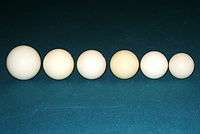
History
.png)
Early balls were made of various materials, including wood and clay (the latter remaining in use well into the 20th century). Although affordable ox-bone balls were in common use in Europe,[1] elephant ivory was favored since at least 1627 until the early 20th century;[2]:17 the earliest known written reference to ivory billiard balls is in the 1588 inventory of the Duke of Norfolk.[3] Dyed and numbered balls appeared around the early 1770s.[2]:17 By the mid-19th century, elephants were being slaughtered for their ivory at an alarming rate, just to keep up with the demand for high-end billiard balls – no more than eight balls could be made from a single elephant's tusks. The billiard industry realized that the supply of elephants (their primary source of ivory) was endangered, as well as dangerous to obtain (the latter an issue of notable public concern at the turn of the 19th century).[2]:17 Inventors were challenged to come up with an alternative material that could be manufactured, with a US$10,000 (worth approximately $192,075 in 2020[4].) prize being offered by a New York supplier,[2]:17 Phelan and Collender.
Although not the first artificial substance to be used for the balls (e.g. Sorel cement, invented in 1867, was marketed as an artificial ivory), John Wesley Hyatt invented a composition material in 1869 called nitrocellulose for billiard balls (US patent 50359, the first American patent for billiard balls). It is unclear if the cash prize was ever awarded, and there is no evidence suggesting he did in fact win it.[2]:17[5] By 1870 it was commercially branded Celluloid, the first industrial plastic. However, the nature of celluloid made it volatile in production, occasionally exploding, which ultimately made this early plastic impractical.[2]:17 Subsequently, to avoid the problem of celluloid instability, the industry experimented with various other synthetic materials for billiard balls such as Bakelite, Crystallite and other plastic compounds.
The exacting requirements of the billiard ball are met today with balls cast from plastic materials that are strongly resistant to cracking and chipping. Currently Saluc, under the brand names Aramith and Brunswick Centennial, manufactures phenolic resin balls.[6][7] Other plastics and resins such as polyester (similar to those used for bowling balls) and clear acrylic are also used.
Ivory balls remained in use in artistic billiards competition until the late 20th century.[2]:17
Types
Carom billiards
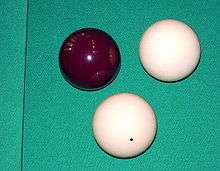
In the realm of carom billiards (or carambole) games, three balls are used to play most games on pocketless billiards tables. Carom balls are not numbered, and are 61–61.5 mm (between approximately 2 3⁄8 and 2 7⁄16 in) in diameter.[8] They are typically colored as follows:
- White cue ball for player 1
- White with a spot (or yellow) cue ball for player 2
- Red (occasionally blue) object ball (four-ball uses an extra object ball.)
Pool
| 1 | solid yellow | |||
| 2 | solid blue | |||
| 3 | solid red | |||
| 4 | solid violet | |||
| 5 | solid orange | |||
| 6 | solid green | |||
| 7 | solid maroon | |||
| 8 | solid black | |||
| 9 | yellow stripe | |||
| 10 | blue stripe | |||
| 11 | red stripe | |||
| 12 | violet stripe | |||
| 13 | orange stripe | |||
| 14 | green stripe | |||
| 15 | maroon stripe | |||
| • | cue ball, white or off-white (sometimes with one or more spots) | |||
Pool balls are used to play various pool games, such as eight-ball, nine-ball and straight pool. These balls, the most widely used throughout the world, are smaller than carom billiards balls, slightly larger than British-style pool balls and substantially larger than those for snooker. According to World Pool-Billiard Association equipment specifications, the weight may be from 5 1⁄2 to 6.0 oz (160–170 g) with a diameter of 2 1⁄4 in (57 mm), plus or minus 0.005 in (0.127 mm).[9][10] The balls are numbered and colored as in the table.
In baseball pocket billiards, the ball set is extended to 21 balls, in which the 16 ball has a black stripe, while balls 17 through 21 have no special design, but look exactly like balls 9 through 13, respectively, except for their numbers.
Balls 1 through 7 are often referred to as solids and 9 through 15 as stripes though there are many other colloquial terms for each suit of balls (highs and lows, etc.). Striped balls were introduced around 1889.[2]:246 Though it looks similar to the solids, the 8 ball is not considered a solid because it is the only ball that is black. Some games such as nine-ball do not distinguish between stripes and solids, but rather use the numbering on the balls to determine which object ball must be pocketed. In other games such as three-ball and straight pool neither type of marking is of any consequence. In eight-ball, straight pool, and related games, all sixteen balls are employed. In the games of seven-ball, nine-ball, and ten-ball, only object balls 1 through 7, 9, or 10, respectively (plus the cue ball) are used.
Some balls used in televised pool games are colored differently in order to make them distinguishable on television monitors. Specifically, the 4 ball is colored pink instead of dark violet, and the 12 is white with a pink stripe, to make it easier to distinguish their color from the black 8 ball, and similarly the 7 and 15 balls use a light tan color instead of a deep maroon. Television was also the genesis of the cue ball with six red spots on its surface (often referred to as a "pro" or "tournament" cue ball) so that spin placed on it is evident to viewers.
Coin-operated pool tables such as those found at bowling alleys, gaming centers, or bars uses a slightly oversized cue ball, so that the cue ball will be separated from object balls in the table's ball return mechanism, and delivered into its own ball return. More modern tables uses a magnetic ball separator and a specially designed cue ball with a thin layer of metal embedded inside; the magnet pulls the cue ball away from the object ball collection chamber and into the cue ball return. In Asia and Europe, some pool tables use a smaller cue ball instead. Modern tables usually employ a magnetic ball of regulation or near-regulation size and weight, since players have complained for many decades that the heavy and often oversized cue balls are more difficult to control.
Blackball pool
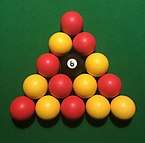
In WPA blackball pool (and its predecessor, WEPF English eight-ball pool) fifteen object balls again are used, but fall into two unnumbered groups, the reds (or less commonly blues) and yellows, with a white cue ball, and black 8 ball. Aside from the 8, shots are not called since there is no reliable way to identify particular balls to be pocketed. Because they are unnumbered they are wholly unsuited to certain pool games, such as nine-ball, in which ball order is important. They are noticeably smaller than the American-style balls, and with a cue ball that is slightly smaller than the object balls, while the table's pockets are tighter to compensate. Neither the WPA nor the WEPF (publicly) define ball or even table dimensions. Most manufacturers that supply this market provide sets that range from 2 inches (51 mm) up to 2 3⁄16 inches (56 mm), often with a slightly smaller cue ball, e.g. 1 7⁄8 in (48 mm) for a 2-inch set. The most common object ball diameters are 2 in (51 mm) and 2 1⁄8 in (54 mm). The yellow-and-red sets are sometimes commercially referred to as "casino sets" (they were formerly used for televised eight-ball championships,[2]:45 most often held in casinos). The use of such sets, however, predates television, as they were used for B.B.C. Co. Pool, the forerunner of modern eight-ball, at least as early as 1908.[2]:24
Snooker
| Colour | Value |
|---|---|
| 1 point | |
| 2 points | |
| 3 points | |
| 4 points | |
| 5 points | |
| 6 points | |
| 7 points |
Ball sets for snooker consist of twenty-two balls in total, arranged as a rack of 15 unmarked reds, six colour balls placed at various predetermined spots on the table, and a white cue ball. The colour balls are sometimes numbered with their point values in the style of pool balls for the home market.
Snooker balls are technically standardized at 52.5 mm (2.07 in) in diameter within a tolerance of plus or minus 0.05 mm (0.002 in). No standard weight is defined, but all balls in the set must be the same weight within a tolerance of 3 g (0.11 oz).[11] However, many sets are actually 2 1⁄16 in (52.4 mm), even from major manufacturers. Snooker sets are also available with considerably smaller-than-regulation balls (and even with ten instead of fifteen reds) for play on smaller tables (down to half-size), and are sanctioned for use in some amateur leagues. Sets for American snooker are typically 2 1⁄8 in (54.0 mm), with numbered colour balls.

The set of eight colours used for snooker balls (including white) are thought to be derived from the game of croquet, which uses the same set of colors. Snooker was invented in 1884 by British Army officers stationed in India. Croquet reached its peak popularity at the same time, particularly amongst people in the same social context. There are many other similarities between croquet and snooker, which when taken together, suggest that the derivation of the latter owes much to the existence of the former.[12]
Other games
Various other games have their own variants of billiard balls. English billiards uses the same number of balls as carom billiards, but the same size as snooker balls, as the game is played on the same size table as snooker.
Russian pyramid uses a set of fifteen numbered, but otherwise all-white, balls and a red or yellow cue ball that are even larger than carom billiards balls at 68 mm (211⁄16 in) or 72 mm (24⁄5 in). Kaisa has the same pocket and ball dimensions but uses only five balls: one yellow, two red and two cue balls, one for each player.[13]
Bumper pool requires four white and four red object balls, and two special balls, one red with a white spot and the other white with red spot; all are usually 2 1⁄8 inch (approximately 52.5 mm) in diameter. Bar billiards uses six or seven white balls (depending on regional variations) and one red ball 1 7⁄8 in (48 mm) in diameter.
Novelty balls
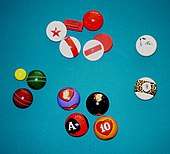
There is a market for specialty cue balls and even entire ball sets, featuring sports team logos, cartoon characters, animal pelt patterns, or other non-standard decorations.
Entrepreneurial inventors also supply a variety of novelty billiard games with unique rules and balls, some with playing card markings, others with stars and stripes, and yet others in sets of more than thirty balls in several suits. Marbled-looking and glittery materials are also popular for home tables. There are even blacklight sets for playing in near-dark. There are also practical joke cue and 8 balls, with off-center weights in them that make their paths curve and wobble. Miniature sets in various sizes (typically 2⁄3 or 1⁄2 of normal size) are also commonly available, primarily intended for undersized toy tables. Even an egg-shaped ball has been patented[14] and marketed under such names as Bobble Ball and Tag Ball.
In popular culture
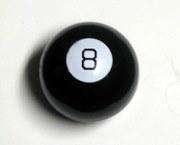
_missile_hatches.jpg)
The 8 ball is frequently used in Western, especially American, culture. It can often be found as an element of T-shirt designs, album covers and names, tattoos, household goods like paperweights and cigarette lighters, belt buckles, etc. A classic toy is the Magic 8-Ball "oracle". A wrestler, a rapper, and a rock band have all independently adopted the name. In the Seinfeld episode "The Reverse Peephole", the character Puddy wears a jacket featuring the eight-ball.
The term "8-ball" is also slang both for 1⁄8 ounce (3.5 g) of cocaine or crystal meth, and for a bottle of Olde English 800 malt liquor. It has also been used to refer to African-Americans, particularly those of darker skin tones, as in the film Full Metal Jacket. The expression "behind the eight [ball]" is used to indicate a dilemma from which it is difficult to extricate oneself. The term derives from the game kelly pool.[15][16][17][18][19]
Because the collisions between billiard balls are nearly elastic, and the balls roll on a surface that produces low rolling friction, their behavior is often used to illustrate Newton's laws of motion. Idealized, frictionless billiard balls are a staple of mathematical theorems and physics models, and figure in dynamical billiards, scattering theory, Lissajous knots, billiard ball computing and reversible cellular automata, Polchinski's paradox, contact dynamics, collision detection, the illumination problem, atomic ultracooling, quantum mirages and elsewhere in these fields.
"Billiard balls" or "pool balls" is the name given to balls used in stage magic tricks, especially the classic "multiplying billiard balls". Though obviously derived from real billiard balls, today they are usually smaller, for easier manipulation and hiding, but not so small and light that they are difficult to juggle, as the magic and juggling disciplines have often overlapped since their successful combination by pioneers like Paul Vandy.
The phrase "as smooth as a billiard ball" is sometimes applied to describe a bald person, and the term "cue ball" is also slang for someone who sports a shaved head.An urban legend received cultural attention to many saying, "If the Earth were the size of a billiard ball, it would be smoother". It was used in 2008's Discover Magazine[20] stating no diameter variations measuring +/-0.005" should be made, but mistook the diameter tolerance for smoothness. If the Earth were reduced to the size of a billiard ball, its mountains and trenches would equal the texture of 320 grit sandpaper and the variation in diameter would be 0.0049", which is near the maximum diameter tolerance.[21] (see also: Earth's Shape)
References
- Note: Antique ox-bone balls remain a very common item on eBay.
- Shamos, Mike (1999). The New Illustrated Encyclopedia of Billiards. New York: Lyons Press. ISBN 1-55821-797-5.
- Everton, Clive (1986). The History of Snooker and Billiards (rev. ver. of The Story of Billiards and Snooker, 1979 ed.). Haywards Heath, UK: Partridge Pr. p. 8. ISBN 1-85225-013-5.
11 balls of yvery
- Federal Reserve Bank of Minneapolis. "Consumer Price Index (estimate) 1800–". Retrieved 1 January 2020.
- "Hyatt". Plastiquarian.com. London: Plastics Historical Society. 2002. Archived from the original on 21 December 2007. Retrieved 26 February 2008.
- Aramith
- "History". brunswickbilliards.com. Archived from the original on 27 March 2014. Retrieved 9 February 2016.
- "World Rules of Carom Billiard" (PDF). UMB.org. Sint-Martens-Latem, Belgium: Union Mondiale de Billard. 1 January 1989. Chapter II ("Equipment"), Article 12 ("Balls, Chalk"), Section 2. Archived from the original (PDF) on 28 September 2007. Retrieved 5 March 2007. Officially but somewhat poorly translated version, from the French original.
- "WPA Tournament Table & Equipment Specifications". WPA-Pool.com. World Pool-Billiard Association. November 2001. Archived from the original on 28 September 2013.
- BCA Rules Committee (2004). Billiards: The Official Rules and Records Book. Colorado Springs: Billiards Congress of America. p. 5. ISBN 978-1-878493-14-9.
- "Equipment" Archived 1 August 2008 at the Wayback Machine, World Snooker Association, publication date unknown (Retrieved 28 January 2007), London, UK.
- "An Introduction to Croquet: A Brief History". The Croquet Association (of England and Wales). Retrieved 13 May 2017.
- "Russian Billiards". CuesUp.com. 2016. Retrieved 28 December 2016.
- U.S. Patent No. 7,468,002
- Shamos, Michael Ian (1993). The Illustrated Encyclopedia of Billiards. New York City: Lyons & Burford. pp. 85, 128 and 168. ISBN 1-55821-219-1.
- Jewett, Bob (February 2002). "8-Ball Rules: The many different versions of one of today's most common games". Billiards Digest Magazine: Pages 22–23.
- Ralph Hickok (2001). Sports History: Pocket Billiards Archived 23 February 2002 at the Library of Congress Web Archives. Retrieved 22 February 2007.
- Billiard Congress America (1995–2005) A Brief History of the Noble Game of Billiards Archived 27 January 2007 at the Wayback Machine by Mike Shamos. Retrieved 22 February 2007.
- Steve Mizerak and Michael E. Panozzo (1990). Steve Mizerak's Complete Book of Pool. Chicago, Ill: Contemporary Books. pp. 127–8. ISBN 0-8092-4255-9.
- "Ten things you don't know about the Earth". Bad Astronomy. 8 September 2008. Retrieved 8 September 2008.
- "IS EARTH AS SMOOTH AS A BILLIARD BALL? NO, HERE'S WHY". Our Planet. 17 August 2017. Retrieved 17 August 2017.
Patents
- U.S. Patent 50,359—Billiard ball c. 1865
- U.S. Patent 76,765—Billiard ball c. 1868
- U.S. Patent 88,634—Billiard ball c. 1869
- U.S. Patent 114,945—Billiard ball c. 1871





